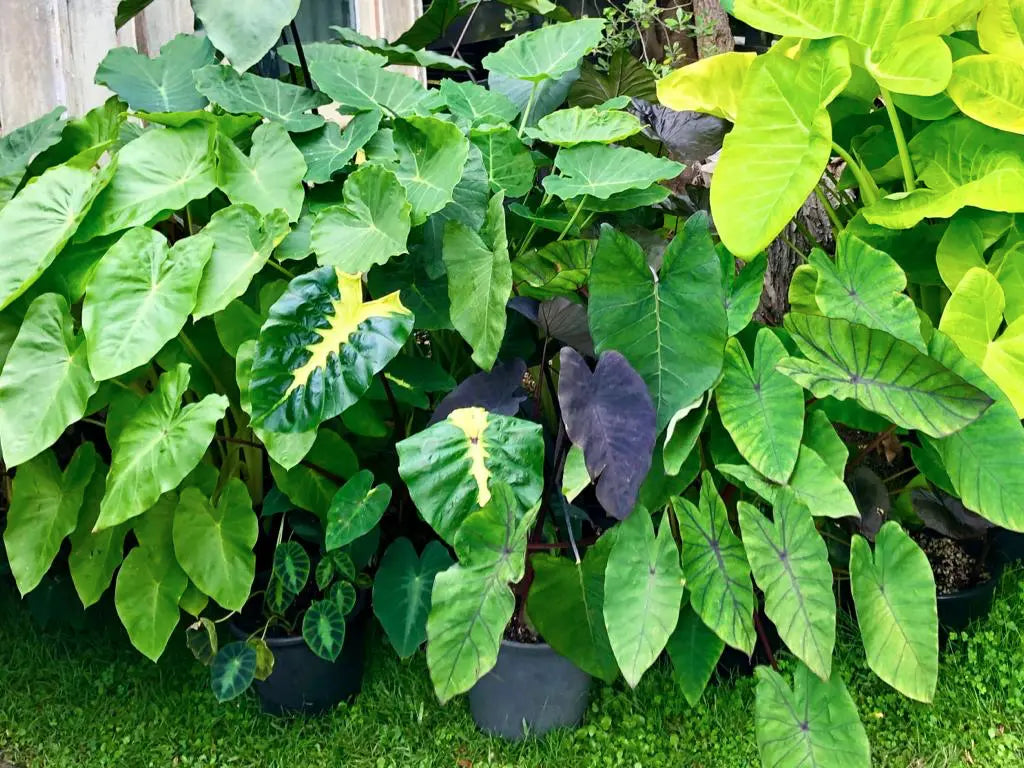Native to South Eastern Asia and the Indian sub-continent, Colocasia are available in many forms and selective breeding has produced a vast array of colour types, but they are almost all variants of the species Colocaisa esculenta commonly known as ‘Taro,’ a valuable food crop throughout the Indo Pacific region.
A tall perennial that will develop a large corm just below the soil surface, they can grow and spread quite quickly. Suitable for indoors or in warmer, frost-free areas of New Zealand, they can be grown outdoors and also can be grown in up to 10cm of standing water, but allow plenty of space for growth!
Often referred to, along with their counterparts Alocasia, as ‘Elephant Ears,’ an easy way to distinguish between the two is that Colocasia (such as our Calocasia Pharoah's Mask) display their leaves with the tip of the leaves pointing down, while the Alocasias typically hold the tip of their leaves out or upward.
At the Green Grower we love this species so have a few forms available.
How much light does your Colocasia need?
Indoors, ensure somewhere bright with indirect light while outdoors, choose a sheltered (especially from winds and frosts) dappled, sunlit area. Some of the dark forms like ‘Black Magic’ require bright sunlight to develop their dark leaf colour.

What type of soil does your Colocasia need?
Indoors, a well-draining potting soil and orchid soil mix (one with a good amount of peat and finer bark content) is best. An aerated soil situation where some moisture is retained is ideal for indoor and outdoor situations. They can be grown as marginal plants outdoors and are great for pond-scaping.
What temperature is best for your Colocasia?
15-28C is the ideal range indoors with good humidity, so the leaves can be misted on warmer summer days. In northern regions of NZ outdoors, always plant so that they are sheltered from extremes of temperature, frosts and wind and remember some forms can grow tall (2m) and spread, therefore your lower growing plants may well be starved of light and sunshine.
Outdoors, they may enter a stage of dormancy in Winter and lose their top growth, only to sprout back as temperatures warm up in mid Spring.
How much water does your Colocasia need?
An evenly moist soil is best with good drainage in the planter. Do not let your plant dry out between watering in the warmer months and make sure you water the soil around the plant, not over the leaves.
Outdoors, especially in the Summer months, if grown in pots these plants can be quite thirsty due to their rapid growth rates so as they develop, they will benefit from early morning watering.
What’s the best fertilizer for your Colocasia?
Use a balanced water-soluble fertiliser to provide the required nutrition every 2-3 weeks, especially in late Spring and early Summer. Be careful not to overfeed before the plant is vigorously growing in mid-Summer.
General Care Tips for your Colocasia.
As previously mentioned, it is normal outdoors especially, for them to die right back in Winter and don’t be alarmed by leaves turning brown; your Colocasia is not dead, just getting ready for its dormant stage, so cut off all ‘ugly’ foliage and stop watering until the new shoots appear in Spring.
Watch out for fungal leaf blight. A spray copper fungicide during wet weather, used less frequently over Summer should keep most pests at bay.
The Green Grower’s Rating of Colocasia.
All parts of the plant are poisonous, but the roots and leaves can be eaten after cooking and indeed find their way into many dishes worldwide. A big showy tropical plant, generally low maintenance, ideal, but need space.

